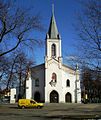Sielec (Sosnowiec)
| Sielec | ||
|---|---|---|
 Help on coat of arms |
|
|
| Basic data | ||
| State : | Poland | |
| Voivodeship : | Silesia | |
| District of: | Sosnowiec | |
| Geographic location : | 50 ° 17 ' N , 19 ° 9' E | |
| Residents : | ||
| Telephone code : | (+48) 32 | |
| License plate : | SO | |
| Economy and Transport | ||
| Next international airport : | Katowice | |
Sielec (formerly also Siedlec ) is a district of Sosnowiec in the Silesian Voivodeship in Poland . Sielec is located on the left, eastern bank of the Black Przemsza , opposite Stary Sosnowiec and Pogoń and has around 20,000 inhabitants.
history
The place was first mentioned in 1361 when it belonged with Klimontów to Otto von Pilcza , the Starost of Ruthenia . In 1386 it was sold with Klimontów and Pogoń from Piotr Szafraniec to Wisław and Piotr from Mysłowice . The often alternating place names Sie (d) lec (singular) and Sie (d) lce (plural) are very common in Poland. The etymology is not always clear, but most of the time it is explained as being associated with the word siodło meaning siedlisko, siedziba (settlement, seat).
The place was on the border with the Duchy of Siewierz in the west and administratively it belonged to the district of Proszowice or Kraków in the Krakow Voivodeship in the Kingdom of Poland (from 1569 in the aristocratic republic of Poland-Lithuania ), but the village was in the Roman Catholic parish in the Upper Silesian city of Mysłowice until the 19th century.
A castle complex was possibly built in the village as early as the 15th century, which was converted into a castle in 1620 by Sebastian Minor from Przybysławice. After the fire in 1824, it was restored in 1832 and the Sielce Hunters' Castle is now considered the oldest building in Sosnowiec.
In the course of the Third Partition of Poland , Prussia became part of New Silesia in 1795 . In 1807 it came to the Duchy of Warsaw and in 1815 to the newly formed Russian-dominated Congress Poland . The Sielec estates were owned by various Germans in the 19th century: Christian Ludwig Schimmelpfennig von der Oye (1802 to 1812), Ludwig Anhalt-Coeten von Pless , Countess Charlotte von Wernigerode zu Stolberg.In 1856, Andreas Maria von Renard bought it for his son Count Jan Renard.
In 1806, the last year it belonged to Prussia, the Ludwigshoffnung colliery was opened. Further industrial development of the place in the Dombrowa coal basin followed in the 1870s with the Fanna colliery , from 1946 the Kopalnia Węgla Kamiennego Sosnowiec and 1881 with the Katarzyna smelter . In 1902 the localities of Sosnowiec (today Stary Sosnowiec), Pogoń, Sielce, Ostra Górka and Radocha were united as the new largest city in the Dombrowa coal basin Sosnowice with around 61,000 inhabitants. In 1934 a tram line was opened, today part of the tram in the Upper Silesian industrial area .
gallery
Web links
Individual evidence
- ↑ Tomasz Jurek (editor): KLIMONTÓW ( pl ) In: Słownik Historyczno-Geograficzny Ziem Polskich w Średniowieczu. Edycja elektroniczna . PAN . 2010-2016. Retrieved April 22, 2019.
- ^ Kazimierz Rymut : Nazwy miejscowe północnej części dawnego województwa krakowskiego . Polska Akademia Nauk . Instytut Języka Polskiego, Wrocław 1967, p. 151–152 (Polish, online ).
- ↑ Franciszek Maron: Proces kształtowania się Wschodniej granicy biskupstwa Wrocławskiego na tle wydarzeń politycznych przełomu XVIII i XIX wieku. Przyczynek do genezy ustaleń bulli "De salute animarum" , 1971, p. 196 (Polish)





